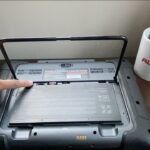The Sprinter’s selective catalytic reduction (SCR) system can be a source of frustration when fault codes prevent resetting the module. This article addresses a common scenario: a full AdBlue tank misread as empty, leading to limp mode and persistent fault codes even after replacing the tank assembly. We’ll explore troubleshooting steps using an Autel MaxiSYS scanner, focusing on how to reset the SCR module and clear engine ECM faults.
A recent repair involved a Sprinter van that entered limp mode due to an inaccurate AdBlue level reading. The initial diagnosis revealed a faulty sensor in the AdBlue tank, reporting a 0% fluid level despite a full tank. Following the replacement of the entire tank assembly and confirmation of a 100% fluid level reading in the SCR module, attempts to reset the system encountered obstacles.
Despite clearing the initial fault code within the SCR module and resetting the AdBlue level, the engine ECM continued to report persistent faults. Specifically, attempts to reset the start counter or the “Selective Catalytic Reduction/AdBlue” warning message failed due to existing fault codes. The primary codes encountered were:
-
P13E300 (Add Blue system warning stage 2. number of engine starts is limited): Indicating a critical AdBlue system issue, limiting the remaining engine starts. Notably, the vehicle could still start despite this code.
-
P152100 (Add Blue system warning: started was disabled by exhaust aftertreatment system): Suggesting the exhaust aftertreatment system is preventing engine starts, although the engine was still starting in this case.
The core problem seems to be the engine ECM’s failure to recognize the resolved AdBlue issue. While the SCR module acknowledges the corrected fluid level, the engine ECM remains locked in a fault state. This points to a communication or software issue between the two modules.
Using the Autel MaxiSYS, several steps were taken to resolve the issue. The SCR module reset procedure was followed, and the AdBlue level was successfully reset within the module. However, the persistent engine ECM fault codes hindered complete system reset. Xentry, an alternative diagnostic tool, was unavailable due to key recognition problems, potentially unrelated to the core issue. All fuses related to the CAN communication system (CIR 15) were checked and confirmed to be functional, ruling out a simple electrical fault.
The challenge lies in persuading the engine ECM to recognize the repairs and clear the persistent fault codes. Possible solutions include using the Autel MaxiSYS to perform a forced regeneration of the SCR system or utilizing advanced diagnostic functions to directly clear the engine ECM fault memory. Further investigation into specific Autel MaxiSYS procedures for addressing this specific scenario is recommended.
In conclusion, resetting the Sprinter SCR module after an AdBlue tank replacement requires a comprehensive approach. While addressing the initial fault and resetting the AdBlue level within the SCR module are crucial, persistent engine ECM codes can prevent a complete system reset. Utilizing the advanced capabilities of the Autel MaxiSYS to force a regeneration or clear the ECM fault memory may be necessary to resolve the issue and restore normal vehicle operation.

